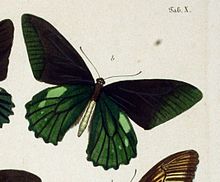| Dyar's swallowtail | |
|---|---|

| |
| Illustration from the Felders' Novara Expedition Atlas, male, dorsal view | |

| |
| Live Battus ingenuus, female, ventral view | |
| Conservation status | |
 Least Concern (IUCN 3.1) | |
| Scientific classification | |
| Domain: | Eukaryota |
| Kingdom: | Animalia |
| Phylum: | Arthropoda |
| Class: | Insecta |
| Order: | Lepidoptera |
| Family: | Papilionidae |
| Genus: | Battus |
| Species: | B. ingenuus |
| Binomial name | |
| Battus ingenuus (Dyar, 1907) | |
| Synonyms | |
| |
Battus ingenuus, the Dyar's swallowtail or confused swallowtail, is a species of butterfly in the family Papilionidae.
Description
Battus ingenuus has a wingspan of about 82–95 millimetres (3.2–3.7 in). The uppersides of the wings are basically black with greenish reflections and pale green patches on the hindwings, while the undersides are mainly brownish, with red and white spots on the edges of the hindwings. The body is blackish, with yellow spots on the sides of the thorax and the abdomen and a few white spots on the underside of the abdomen. Males have a pale yellowish-greenish upper abdomen.
Distribution

Battus ingenuus is present from southeastern Mexico to eastern Venezuela (Belize, Colombia, Costa Rica, Ecuador, El Salvador, Honduras, Nicaragua, Panama, Peru and Trinidad).
Habitat
Battus ingenuus can be found from low elevations up to moderate elevations in the Andes, at about 900 metres (3,000 ft) above sea level. In monsoonal areas of Costa Rica, the habitat is known as tropical deciduous forest, where most of the trees lose their leaves at the end of the dry season.
Life cycle
The larvae feed on Aristolochia constricta. As the caterpillars feed off these poisonous pipevines, the insects become poisonous themselves, tasting very bad to birds.
References
- ^ Warren, A. D.; et al. (2010). "Battus ingenuus". Butterflies of America. Retrieved 24 January 2011.
- Glassberg, Jeffrey (2007). A Swift Guide to the Butterflies of Mexico and Central America. Sunstreak Books Inc. p. 9. ISBN 978-1-4243-0915-3.
- DH Janzen & W Hallwachs Area de Conservación Guanacaste (ACG)
- ^ Savela, Markku. "Battus ingenuus". funet.fi. Retrieved 24 January 2011.
- Globis.insect
Further reading
- Lamas, Gerardo (2004). Atlas of Neotropical Lepidoptera; Checklist: Part4A Hesperioidea–Papilionoidea. Gainesville, Florida: Scientific Publishers, Inc. p. 90. ISBN 0-945417-28-4.
- Edwin Möhn, 2002 Schmetterlinge der Erde, Butterflies of the World Part V (5), Papilionidae II: Battus. Edited by Erich Bauer and Thomas Frankenbach Keltern: Goecke & Evers; Canterbury: Hillside Books. ISBN 978-3-931374-70-9 Illustrates and identifies 14 species and 49 subspecies. Page 7, plate 11, figures 1–8, plate 19, figures 7–8.
External links
- Neotropical Butterflies
- "Battus ingenuus (Dyar, 1907)". Insecta.pro.
- Sangay National Park Ecuador
- Real life image of Battus ingenuus
| Taxon identifiers | |
|---|---|
| Battus ingenuus | |
| Papilio ingenuus | |
- IUCN Red List least concern species
- Battus (butterfly)
- Butterflies of Central America
- Fauna of Costa Rica
- Butterflies of Trinidad and Tobago
- Papilionidae of South America
- Lepidoptera of Bolivia
- Fauna of Panama
- Lepidoptera of Colombia
- Lepidoptera of Ecuador
- Lepidoptera of Peru
- Lepidoptera of Venezuela
- Butterflies described in 1907
- Fauna of Belize
- Taxa named by Harrison Gray Dyar Jr.